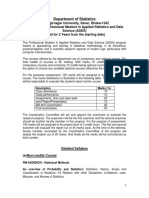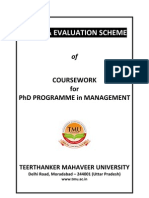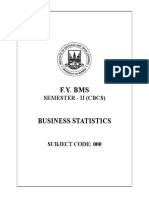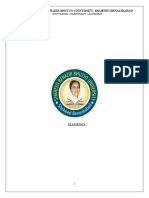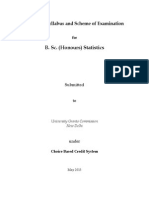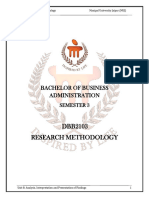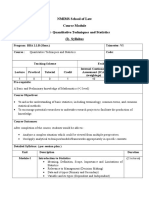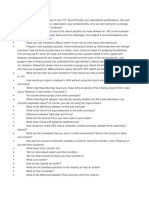M. Phil. in Statistics: Syllabus
M. Phil. in Statistics: Syllabus
Uploaded by
sivaranjani sivaranjaniCopyright:
Available Formats
M. Phil. in Statistics: Syllabus
M. Phil. in Statistics: Syllabus
Uploaded by
sivaranjani sivaranjaniOriginal Title
Copyright
Available Formats
Share this document
Did you find this document useful?
Is this content inappropriate?
Copyright:
Available Formats
M. Phil. in Statistics: Syllabus
M. Phil. in Statistics: Syllabus
Uploaded by
sivaranjani sivaranjaniCopyright:
Available Formats
Department of Statistics
(School of Physical and Decision Sciences)
SYLLABUS
FOR
M. Phil. in Statistics
(2019 onwards)
Babasaheb Bhimrao Ambedkar University
(A Central University)
Vidya Vihar, Raibareli Road,
Lucknow-226025
Prof. Madhulika Dube
Head
Department of Applied Statistics, BBAU, Lucknow - 226025 Page 1
DEPARTMENT OF STATISTICS
(SCHOOL OF PHYSICAL AND DECISION SCIENCES)
Babasaheb Bhimrao Ambedkar University Lucknow-226025
Course Details (M. Phil. in Statistics)
Course - M. Phil.
Semester - Two
Nature of Course - Regular
Total Intake - 20
Total Credit - 36
Teaching/ Contact Hours - 180 per semester
Course Fee - 10,000 per Semester
Faculty Requirement - Two
Department of Applied Statistics, BBAU, Lucknow - 226025 Page 2
DEPARTMENT OF STATISTICS
(SCHOOL OF PHYSICAL AND DECISION SCIENCES)
Babasaheb Bhimrao Ambedkar University Lucknow-226025
COURSE STRUCTURE FO R M. PHIL. IN STATIS TICS 2019 ONWARDS
SEMESTER I
S/N COURSE CODE PAPER TITLE Credit
1 MPS 101 RESEARCH METHODOLOGY Credit-06
2 MPS 102-109 OPTIONAL PAPER (Every eligible guide Credit-06
of a department shall offer one course related
to his/her field to specialization. Students
shall be free to choose one of these courses as
per their research interest)
3 MPS 110 STATISTICAL SOFTWARE & Credit-06
LAB SESSIONS
SEMESTER II
S/N COURSE CODE PAPER TITLE Credit
1 MPS 201 DISSERTATION Credit-14
2 MPS 202 SEMINAR PRESENTATION & Credit-04
VIVA-VOCE
Each paper shall carry 100 marks the breakup of which is as follows.
a. Written Examination: 70 marks
b. Internal Assessment (Class performance/ Presentation): 30 marks.
Department of Applied Statistics, BBAU, Lucknow - 226025 Page 3
SEMESTE- I
PAPER I. RESEARCH METHODOLOGY (MPS 101) (6 credits)
Introduction to Statistical Research, Statistical Research Process, Statistical Research Design
and Implementation, Measurement Concepts in Statistical Research, Secondary Data, Survey
Research, Types of Measurement Scales: Nominal Scale, Ordinal Scale, Interval Scale, Ratio
Scale – Criteria For Good Measurement, Concept of Scaling, Introduction of Qualitative Data
Analysis.
Definition of Research, Characteristics of Research, Criteria of good Research, Research in
Statistics, Meaning of Statistical Research, Need of Statistical Research, Area of Research,
Advantages of Statistical Research, Limitations of Statistical Research.
Research Proposal, Meaning of Research Proposal, Need and Importance of Research
Proposal, Types of Research Proposal, Benefits of Research Proposal.
Heuristic Research Approach, Phenomenological Research Approach, Interdisciplinary
Research Approach, Ethnographical Research Approach.
Research Design, Informal Research Design, Formal Research Design
Research Problem, Meaning of Research Problem, Importance of Research Problem, Steps in
identifying Research Problem, Criteria of selecting Research Problem, Evaluation of Research
Problem, Characteristics of Good Research Problem, Research Questions.
Meaning of Hypothesis, Criteria for Hypothesis Construction, Importance of Hypothesis,
Types of Hypothesis, Testing of Hypotheses, Assumptions.
Review of Related Literature, Meaning of Review of Related Literature, Objectives of Review
of Literature, Need of Review of Literature, Impact Factor.
Concept of Research Tools and Techniques, Types of Research Tools and Techniques,
Questionnaire, Check list, Interview Schedule, Observation.
Research Report and Research Paper, Concept of Research Report and Research Paper,
Purpose of Research Report and Research Paper, Norms of Research Report and Research
Paper, Format of Research Report and Research Paper, Style and Language of Research Report
and Research Paper, Technical aspects of Thesis/ Dissertation, Evaluation of Research Report
and Research Paper, References, Appendix.
REFERENCES:
1. Pauline V Young Research Methodology
2. Kothari C. R. Research Methodology, New Age Publications, New Delhi
Department of Applied Statistics, BBAU, Lucknow - 226025 Page 4
PAPER II. ADVANCE GENERAL PAPER (OPTIONAL PAPER) (6 credits)
STATISTICAL INFERENCE (MPS 102):
Properties of good estimators, Unbiasedness, Consistency, Efficiency, Sufficiency Minimal
sufficient statistics and Completeness. Cramer-Rao, Bhattacharya bounds. Minimum variance
unbiased estimators, Rao-Blackwell Theorem. Lehman-Scheffe theorem and their applications.
Method of Estimation, Method of Maximum Likelihood, Method of Moments, Method of Chi-
Square, properties of M.L.E. Location Invariance, scale invariance. Pitmann’s estimators for
location and scale parameters.
Neymann–Pearson fundamental lemma – distributions with monotone likelihood ratio
confidence bounds, UMP tests for the two sided hypothesis – tests for parameters in a normal
distribution.
Unbiased tests: Concept of unbiasedness – application to one parameter exponential family –
similarly and completeness – UMP unbiased tests for multi parameter exponential families–
comparison of two Poisson and Binomial population - Application of unbiasedness.
Invariant tests: Symmetry and invariance – maximal invariance - most powerful invariant tests
– unbiasedness and invariance.
REFERENCES:
1. Lehman E.L. and Casella: Theory of Point Estimation, Springer Verlag, 1988.
2. Lehman E.L. : Testing Statistical Hypothesis, John Wiley & Sons, 1986.
3. Rohatgi V.K. : Introduction to mathematical Statistics, Wiley Eastern, 1984.
4. Zacks S.: Theory of Statistical Inference, John Wiley & Sons, 1991
5. Ferguson T.S. : Mathematical Statistics - A decision theoretic approach, Academic Press,
1967.
6. Kale B. K : A first course on parametric inference, Narosa Publication, New Delhi, 1999.
SAMPLING TECHNIQUES (MPS 103):
Unequal probability sampling: ppswr and wor methods (including Lahiri's scheme) and related
estimators of a finite population mean (Hansen-Hurwitz and Desraj estimators for general
sample size and Murthy's estimator for a sample of size 2).
Horvitz-Thompson estimator, its variance and unbiased estimator of variance, IPPS schemes of
sampling due to Midzuno-Sen, Rao-Hartley-Cochran and Samphord.
Department of Applied Statistics, BBAU, Lucknow - 226025 Page 5
The Jackknife and Bootstrap : estimate of bias, estimate of variance. Ratio Estimation in
reference to Jackknife and bootstraps, Relationship between the jackknife and the bootstrap.
Interpenetrating sub sampling.
Resampling techniques for variance-estimation; estimation of the population variance using
auxiliary information
Successive Sampling, sampling for two occasion for estimation of population mean, population
ratio etc., estimation of change in mean.
Non-sampling errors. Non response errors, Hansen Hurwitz method for tackling non response,
Randomized Response techniques (Warner's method: related and unrelated questionnaire
methods).
REFERENCES:
1. Chaudhuri, A. and Mukerjee, R. (1988): Randomized Response: Theory and
Techniques, New York: Marcel Dekker Inc.
2. Cochran, W.G.: Sampling Techniques (3rd Edition, 1977). Wiley.
3. Des Raj and Chandok (1998): Sampling Theory, Narosa.
4. Murthy, M. N. (1977): Sampling Theory & Methods, Statistical Publishing Society,
Calcutta.
5. Sukhatme et al (1984): Sampling Theory of Surveys with Applications. lowa state
University Press & IARS.
6. Singh, D. and Chaudhary, F.S. (1986): Theory and Analysis of Sample Survey Designs.
New Age International Publishers.
7. Gray, H.L., and Schucany(1972) : The generalized jackknife statistic. New York.
Marcel Dekker, Inc.
BAYESIAN INFERENCE (MPS 104):
Regular exponential families, conjugate and canonical conjugate analysis, weighted average
form of posterior expectation, Conjugate families for samples from a multivariate normal
distribution, mixtures of priors, maximal data information prior, Jeffrey’s noninformative
invariant priors.
Posterior distribution of correlation coefficient, bivariate regression, general linear model, one-
way model and its relationship to ANOVA.
Loss functions, estimation of functions of population means and regression coefficient, Linear
Bayes estimation, Emperical Bayes point estimation, estimation of the prior distribution.
Informative prediction; Regulation, optimization, calibration and diagnosis problems.
Department of Applied Statistics, BBAU, Lucknow - 226025 Page 6
Bayesian analysis of changing sequence of random variables, detection of a change and
estimation of a change point, predication. Large sample posterior distribution; Approximate
evaluation of Bayesian integrals; Lindleys approximation, Tierney-Kadane approximation.
REFERENCES:
I. Aitchison, J. and Dunsmore, I.R. (1975): Statistical Prediction Analysis, Cambridge
University Press.
2. Berger, J.O. (1985): Statistical Decision Theory and Bayesian Analysis, Second Edition,
Springer Verlag, New York.
3. Bemardo, J.M. and Smith, A.F.M. (1994): Bayesian Theory, John Wiley and Sons, New
York.
4. Broemeling, L.D. and Tsurmi, M. (1987): Econometrics and Structural Change, Marcel
Dekker, Inc. New York.
5. Lee, P.M. (1989): Bayesian Statistics; an Introduction, Oxford University Press.
6. Mariz, J.S. and Lwin, T. (1989): Empirical Bayes Methods, II Edition, Chapman and Hall,
London.
7. Press, S. J. (1989): Bayesian Statistics: Principles, Models and Application, John Wiley and
Sons.
8. Zellner, A. (1984): Bassic Issues in Econometrics, The University of Chicago Press,
Chicago.
RELIABILITY THEORY AND SEQUENTIAL TESTING (MPS 105):
Reliability, hazard-rate and mean time to failure and their inter-relationships. Exponential
distribution, memory less property. Maximum likelihood estimation and uniformly minimum
variance unbiased estimation for the parameter and reliability function.
Gamma and Weibuil distributions. Estimation of parameters and reliability function with
complete and censored samples. Estimation with regression approach. Normal and lognormal
distributions-estimation of parameters and reliability with complete samples.
Tests of hypotheses and confidence intervals for the reliability function of exponential,
gamma,Weibull, normal and lognormal distributions.
Sequential Analysis: Need of Sequential probability Ratio test and it’s properties, Wald’s
fundamental identity, OC and ASN function, Optimality of SPRT. Applications to Normal,
Binomial and Poisson Distribution. Sequential estimation – Basic idea, Stein’s two stage
procedure.
REFERENCES:
Department of Applied Statistics, BBAU, Lucknow - 226025 Page 7
I. Bain, L.J. and Engelhardt, M. (1991): Statistical Analysis of Reliability and Life- Testing
Models. Marcel Dekker Inc., U.S.A. -
2. Cohen, A.C. and Whitten, B.J. (1988): Parameter estimation in Reliability and Life Span
Models. Marcel Dekker Inc., U.S.A.
3. Gerstbakh, I.B. (1989): Statistical Reliability Theory. Marcel Dekker Inc., New York.
4. Hoyland, A. and Rausand, M. (1994): System Reliability Theory: Models and Statistical
Theory. Marcel Dekker Inc., New York.
5. Kalbfleisch, J.D. and Prentice, R.L. (1980): The Statistical Analysis of Failure Time Data.
John Wiley and Sons, New York.
6. Lawless, J.F. (1982): Statistical Models and Methods for Lifetime Data. John Wiley and
Sons Jnc.,.U.S.A.
7. Mann, N.R., Schafer, R.E. and Singpurwala, N.D. (1974): Methods for Statistical Analysis
of Reliability and Life Data. John Wiley, New York.
8. Martz, H.F. and Wailer, R.A. (1982): Bayesian Reliability Analysis. John Wiley and Sons,
Inc., New York.
9. Sinha, S.K. (1986): Reliability and Life-Testing. Wiley Eastern Ltd., New Delhi.
10. Sinha, S.K. (1998): Bayesian Estimation. New Age Publication.
11. Zacks, S. (1992): Introduction to Reliability Analysis. Springer-Verlag, U.S.A.
12. Wald A. (1947): Sequential Analysis. John Willy and sons, New York.
ECONOMETRICS AND TIME SERIES (MPS 106):
Models containing function of the predictors, including polynomial models, Use of orthogonal
models, Hypotheses for one and more than one linear parametric functions, Confidence
regions, Analysis of Variance, Power of F-test. Multiple comparison tests due to Tukey and
Scheffe, Simultaneous confidence intervals.
The general linear model (GLM) and its extensions, Use of dummy variables and seasonal
adjustment, Generalized least squares (GLS) estimation and prediction, Heteroscedastic
disturbances, Pure and mixed estimation, Grouping of observations and of equations.
Auto correlation, its consequences and tests, Theil BLUS procedure: estimation and prediction,
Multicollinearity problem, its implications and tools for handling the problem, Ridge
regression.
Linear regression with stochastic regressors, Instrumental variable estimation, Errors in
variables, Autoregressive linear regression, Distributed lag models.
Department of Applied Statistics, BBAU, Lucknow - 226025 Page 8
Time Series - General linear filter model, Autoregressive (AR(p)) models, Moving average
model (MA(q)), Autoregressive, Moving average (ARMA(p,q)) models, Autoregressive
integrated moving average model (ARIMA(p,d,q))
REFERENCES:
1. Cook, R.D. and Weisberg, S. (1982): Residual and Influence in Regression. Chapman
and Hall.
2. Draper, N.R.and Smith, H. (1998): Applied Regression Analysis, Third Edition Wiley.
3. Guest, R.F. and Mason, R.L. (1980): Regression analysis and its Applications - A Data
Oriented Approach. Marcel and Dekker.
4. Rao, C.R. (1973): Linear statistical inference and its Applications. Wiley Eastern.
5. Weisberg, S. (1985): Applied Linear Regression. Wiley.
6. Anderson, T.W. (1971). The Statistical Analysis of Time Series, John Wiley, New York.
7. Box, G.E.P. and Jenkins, G.M. (1976). Time Series Analysis- Forecasting and Control,
Holden-day, San Francisco.
8. Kendall, Sir Maurice and Ord, J.K. (1990), Time Series, Edward Arnold, London.
9. Fuller, W.A. (1976). Introduction to Statistical Time Series, John Wiley, New York.
10. Montgomery, D.C. and Johnson, L.A. (1977) Forecasting and Time Series Analysis,
McGraw Hill, New, York.
SAMPLING DESIGN & MATHEMATICAL PROGRAMMING TECHNIQUES
(MPS 107):
Estimation of population mean, total and proportion in SRS and Stratified sampling, estimation
of gain due to stratification, methods of allocation with more than one characteristics:
Chatterjee and Cochran methods, ratio and regression methods of estimation, optimality of
ratio estimate, cluster sampling: estimation of population mean and their variances based on
cluster of equal sizes, variance in terms of intra-class correlation coefficient, two stage
sampling: estimation of population total and mean with equal first stage units, variances and
their estimation, optimum sampling and sub-sampling fractions, double sampling, double
sampling for stratification.
Integer Programming: Gomory’s f-cut, Branch and Bound method: Branching, bounding and
fathoming.
Dynamic Programming: Bellman’s principle of optimality, the general characteristics of
Dynamic Programming Problems, Solutions of L.P. problems by D.P.
Department of Applied Statistics, BBAU, Lucknow - 226025 Page 9
The general Nonlinear Programming Problem, difficulties introduced by nonlinearity, the
Kuhn-Tucker necessary conditions for optimality, solution of simple NLPP using K-T
conditions, Quadratic Programming: Wolfe’s method and Beale’s method.
Multi-objective Programming Problems, solutions by various distance based methods, Goal
Programming, Lexicographic Goal Programming.
REFERENCES:
Bazara, M.S., Sherali, H.D. and Shetty, C.M. (2006): Nonlinear Programming: theory and
algorithms, Wiley, New York.
Cochran, W.G. (1977): Sampling Techniques, 3rd edition, John Wiley & Sons, New York.
Hillier, F.S. and Leiberman, G.J. (2001): Introduction to operations research; McGraw-
Hill, New York.
Murthy, M.N. (1977): Sampling theory and methods, Statistical Publishing Society,
Calcutta.
Rao, S.S. (1984): Optimization: theory and applications: how Michael ‘selected’ Amy.
Kluwer Academic Publishers, Dordrecht.
Sukhatme, P.V., Sukhatme, B.V., Sukhatme, S. and asok, C. (1984): Sampling theory of
surveys with applications. 3rd edition, Iowa State University Press, Iowa and Indian
Society of Agriculture Statistics, New Delhi.
Taha, H.A. (2011): Operations research: an introduction, Ninth edition Pearson, India.
Wagner, H.M. (1975): Principles of Operations research: with applications to managerial
decisions: Prentice Hall Inc., N.J.
STOCHASTIC ORDERS (MPS 108):
Univariate Stochastic Orders: The usual stochastic order, the hazard (reserved hazard) rate
order, the likelihood ratio order, the mean residual life order, the convex (concave) order, the
dispersive order, the monotone convex (concave) order, star and super-additive order.
Closure properties of these orders, different characterization and properties of these orders.
Applications of these orders in reliability theory, economics, etc.
Multivariate Stochastic Orders: The usual multivariate stochastic order. The multivariate
hazard rate order, the multivariate likelihood ratio order, the multivariate reversed hazard rate
order. Properties and applications of these orders.
Relation between stochastic ageing and stochastic orders.
Department of Applied Statistics, BBAU, Lucknow - 226025 Page 10
REFERENCES:
Barlow, R.E. and Proschan, F. (1975). Statistical Theory of Reliability and Life Testing.
Holt, Rinehart and Winston, New York.
Lai, C.D. and Xie, M. (2006). Stochastic Ageing and Dependence for Reliability.
Springer, New York.
Marshall, A.W. and Olkinn, I. (2007). Life Distributions, Springer, New York.
Muller, A. and Stoyan, D. (2002). Comparison Methods for Stochastic Models and Risk,. John
Wiley.
Shaked, M. and Shantikumar, J.G. (2007). Stochastic Orders. Springer, New York.
SOFT COMPUTING (MPS 109):
Introduction to Soft Computing, Historical Development, Definitions, advantages and
disadvantages.
Neural Networks: Fundamentals, Neural Network Architectures, Feedforward Networks,
Backpropagation Networks.
Fuzzy Logic: Fuzzy Sets, Fuzzy numbers, Fuzzy Systems, membership functions, fuzzification,
defuzzification
Application of Soft Computing Techniques.
REFERENCES:
Klir, G. J. and Yuan, B.: "Fuzzy Sets and Fuzzy Logic: Theory and Applications", Prentice
Hall. 1995
Rajasekaran, S. and Vijayalakshmi Pai, G.A.: “Neural Networks, Fuzzy Logic and Genetic
Algorithms: Synthesis and Applications”, Prentice Hall of India. 2003
Sinha, N.K. and Gupta, M. M. : “Soft Computing and Intelligent Systems - Theory and
Applications”, Academic Press. 2000
Tettamanzi, A., Tomassini, M.: “Soft Computing: Integrating Evolutionary, Neural, and
Fuzzy Systems”, Springer.
PAPER III. STATISTICAL SOFTWARE &LAB SESSIONS (MPS 110) (6 credits)
Historical evolution of computers, Generations of Computers, Classification of Computers,
Hardware : CPU, I/O Devices, Block diagram. System Software.
Department of Applied Statistics, BBAU, Lucknow - 226025 Page 11
Windows : The user Interface, The Desk Top, The Task Bar, The Control Panel, The Find
Features, Properties, Font Management, Systems Tools, Character Map, Note Pad, The My
Computer ICON, Folders, Short-Cuts. Word Processing : Creating and Saving a document,
Editing the text; Printing Documents.
Working with Software Packages : MS-Office, SPSS, FORTRAN and R-Language.
1. Classification, Tabulation and Frequency Tables.
2. Bar Graphs, DOT Diagram and Histogram
3. Stem-and-Leaf Plots.
4. Box Plots.N
5. Summary Statistics
6. Two-way tables and plots.
7. Product moment correlation coefficient, Rank Correlation coefficient.
8. Curve setting by method of least squares: Exponential and polynomial (upto three degree)
equations.
9. Fitting Regression lines
10. Correlation ratios.
11. Multiple and partial correlation coefficients. Regression equations (for three variables
only).
12. Rank and Inverse of a matrix
13. Fitting of Binomial, Poisson, Negative Binomial, Normal and Gamma Distributions.
Programming with R-Language. Interpretation of Software output.
SEMESTER II
PAPER 1 DISSERTATION (MPS 201) (14 credits)
PAPER 2 SEMINAR PRESENTATION & VIVA-VOCE (MPS 202) (4 credits)
Each paper shall carry 100 marks the breakup of which is as follows.
c. Written Examination: 70 marks
d. Internal Assessment (Class performance/ Presentation): 30 marks.
Department of Applied Statistics, BBAU, Lucknow - 226025 Page 12
You might also like
- Forecasting: Questions and Answers Q6.1 Q6.1 AnswerDocument28 pagesForecasting: Questions and Answers Q6.1 Q6.1 AnswerjyottsnaNo ratings yet
- Multiple Choice Problem CH 12Document29 pagesMultiple Choice Problem CH 12meyyNo ratings yet
- Agra University Journal ScieDocument69 pagesAgra University Journal ScieDeepti GaurNo ratings yet
- 6th Sem StatisticsDocument2 pages6th Sem Statisticssalamabid464No ratings yet
- 4th Sem Detailed Syllabus (B. Sc. in Data Science)Document5 pages4th Sem Detailed Syllabus (B. Sc. in Data Science)kbhowalNo ratings yet
- MSC SyllabusDocument14 pagesMSC SyllabusSubrata DasNo ratings yet
- Statistics ElectDocument8 pagesStatistics ElectSiddharth DasNo ratings yet
- B A (Applied) 2023617144123101Document11 pagesB A (Applied) 2023617144123101Harishankar SinhaNo ratings yet
- F.Y.B.Sc. Computer Science (Statistics) - 14.082019Document13 pagesF.Y.B.Sc. Computer Science (Statistics) - 14.082019nisharpasalkar2003No ratings yet
- PM-ASDS Final Syllabus - 2019-2021Document19 pagesPM-ASDS Final Syllabus - 2019-2021M Masrur IkramNo ratings yet
- Ku BiostatsDocument1 pageKu Biostatssrinivask.zoologyNo ratings yet
- UG Syllabus (GE) STAT W.E.F 2020-21 - 15.09.2021-Pages-49-57-1Document9 pagesUG Syllabus (GE) STAT W.E.F 2020-21 - 15.09.2021-Pages-49-57-1Pallavi TiwariNo ratings yet
- ASOLMA 2019flyerDocument1 pageASOLMA 2019flyerNitish BharadwajNo ratings yet
- Lecture Plan@2023-24 MA 231Document2 pagesLecture Plan@2023-24 MA 231amancollege8864No ratings yet
- PSYCH 248 Hunter Summer 2019Document4 pagesPSYCH 248 Hunter Summer 2019PohuyistNo ratings yet
- QMS 102 Course PlanDocument5 pagesQMS 102 Course Planofficialrrk06No ratings yet
- Statistics 1Document53 pagesStatistics 1vishalprojects8899No ratings yet
- MTS-PST-311 Course Outline (BGEN3, BMEN3, and BMMP3) - 2024Document8 pagesMTS-PST-311 Course Outline (BGEN3, BMEN3, and BMMP3) - 2024Malack ChagwaNo ratings yet
- Agarwal StatisticsDocument10 pagesAgarwal StatisticsSamir Ul HassanNo ratings yet
- 1-STAT-302_Spring 2019 (4 Slides Per Page Can Be Printed)Document25 pages1-STAT-302_Spring 2019 (4 Slides Per Page Can Be Printed)Roy TufailNo ratings yet
- Syllabus For PGDRSM 2012-13Document11 pagesSyllabus For PGDRSM 2012-13ibrahimNo ratings yet
- Statistics 30.4.2009Document97 pagesStatistics 30.4.2009Abhishek S SNo ratings yet
- BSC Statistics Syllabus 01122015Document16 pagesBSC Statistics Syllabus 01122015sandhyaNo ratings yet
- 120E1BDocument1 page120E1BSri VarsaNo ratings yet
- Statistics For Business-IIDocument3 pagesStatistics For Business-IINagiib Haibe Ibrahim Awale 6107100% (1)
- Course - Outline - PBH 711.2 - Spring - 2024Document3 pagesCourse - Outline - PBH 711.2 - Spring - 2024sd.ashifNo ratings yet
- Courses P'rogram DetailDocument7 pagesCourses P'rogram DetailZehra KhanNo ratings yet
- Course Work PHD ManagementDocument6 pagesCourse Work PHD ManagementDrSanjay RastogiNo ratings yet
- QTBD-Term IDocument3 pagesQTBD-Term IJayesh gaurNo ratings yet
- Statistics Sem 2Document21 pagesStatistics Sem 2shruti JainNo ratings yet
- B.SC StatisticsDocument16 pagesB.SC StatisticsGowthami MarreddyNo ratings yet
- B.SC Statistics PDFDocument16 pagesB.SC Statistics PDFsrinivasprashantNo ratings yet
- Business StatisticsDocument3 pagesBusiness Statisticsatulfybca138No ratings yet
- University of Sargodha Department of Statistics M.Phil. Statistics (2 Years Program)Document31 pagesUniversity of Sargodha Department of Statistics M.Phil. Statistics (2 Years Program)Noman ZahoorNo ratings yet
- BSC StatDocument12 pagesBSC StatpaswanrudranchalNo ratings yet
- Fundamental of Stat by S C GUPTADocument13 pagesFundamental of Stat by S C GUPTAPushpa Banerjee14% (7)
- Syllabus - Quanttitative Techniques and StatisticsDocument2 pagesSyllabus - Quanttitative Techniques and StatisticsNaveen ShahNo ratings yet
- 125E1BDocument1 page125E1BSamprithiNo ratings yet
- Ashwini CVDocument3 pagesAshwini CVAshwini Kumar MauryaNo ratings yet
- StatisticsDocument3 pagesStatisticsKEERTHANA DEVI ANo ratings yet
- Prospectus of StatisticsDocument8 pagesProspectus of StatisticsShreesha Bhat KailankajeNo ratings yet
- 227E3BDocument1 page227E3BJovitha JoelNo ratings yet
- CRT, .4, Utztt. 196: Symbiosis College of Arts and Commerce: Statistical MethodsDocument1 pageCRT, .4, Utztt. 196: Symbiosis College of Arts and Commerce: Statistical MethodsRicha PandeyNo ratings yet
- FYBMS Business Statistics SEM IDocument272 pagesFYBMS Business Statistics SEM IUsama KhatibNo ratings yet
- STATISTICSDocument14 pagesSTATISTICSMuhammad SohaibNo ratings yet
- B. SC (Honours) StatisticsDocument58 pagesB. SC (Honours) StatisticshareshNo ratings yet
- RPS FIS622104 Statistika SosialDocument7 pagesRPS FIS622104 Statistika Sosialmulyadi981No ratings yet
- PHD SyllabusDocument50 pagesPHD SyllabusAravind RameshNo ratings yet
- Sot MergedDocument315 pagesSot MergedDr Praveen KumarNo ratings yet
- 240E3A - Statistics For Behavioral ScienceDocument3 pages240E3A - Statistics For Behavioral Sciencesrinithat91No ratings yet
- Prof. U.J.DixitDocument11 pagesProf. U.J.DixitMalik MalikNo ratings yet
- 220E3BDocument1 page220E3Barasupoov0No ratings yet
- Course Outline - SDM - PGP T1 2024Document6 pagesCourse Outline - SDM - PGP T1 2024lazyaturgateNo ratings yet
- Indian Statistical Institute: Students' BrochureDocument8 pagesIndian Statistical Institute: Students' Brochurerushikes80No ratings yet
- LP StatsDocument34 pagesLP StatsadityakhatawkaropNo ratings yet
- Sem4 CP AllDocument14 pagesSem4 CP Allsignin2703No ratings yet
- Stat 205Document4 pagesStat 205Nasir AliNo ratings yet
- DBB2103 Unit-08 - V1.2Document32 pagesDBB2103 Unit-08 - V1.2anamikarajendran441998No ratings yet
- Syllabus - SFMDocument4 pagesSyllabus - SFMsinnerNo ratings yet
- BCN DSC15Document2 pagesBCN DSC15sanjeevrk051No ratings yet
- Course Module - StatsDocument13 pagesCourse Module - StatsNaveen ShahNo ratings yet
- EDUCATION DATA MINING FOR PREDICTING STUDENTS’ PERFORMANCEFrom EverandEDUCATION DATA MINING FOR PREDICTING STUDENTS’ PERFORMANCENo ratings yet
- PSNM Probality Tutorial 201920Document29 pagesPSNM Probality Tutorial 201920Heer PatelNo ratings yet
- Feature Engg Pre Processing PythonDocument68 pagesFeature Engg Pre Processing PythonGaurav RohillaNo ratings yet
- Lecture 11 - SimplerLinear and Simple Logistic RegressionDocument31 pagesLecture 11 - SimplerLinear and Simple Logistic RegressionRhemaNo ratings yet
- Interview QuestionsDocument4 pagesInterview QuestionsMahima Sharma100% (1)
- Effect of Electronic Word of Mouth (E-WOM) and Instagram Account On Purchase IntentionDocument5 pagesEffect of Electronic Word of Mouth (E-WOM) and Instagram Account On Purchase IntentionInternational Journal of Innovative Science and Research TechnologyNo ratings yet
- The Gauss Markov TheoremDocument17 pagesThe Gauss Markov TheoremSamuel100% (2)
- Statistical Graphs and CalculationsDocument29 pagesStatistical Graphs and Calculationsathembo georgeNo ratings yet
- Chapter1 - An Overview of Regression AnalysisDocument35 pagesChapter1 - An Overview of Regression AnalysisZiaNaPiramLiNo ratings yet
- Module 5Document26 pagesModule 5Kim Daniel EstoyNo ratings yet
- Unit 3 Modelling and EvaluationDocument40 pagesUnit 3 Modelling and EvaluationYash DesaiNo ratings yet
- Adv Stats 14Document261 pagesAdv Stats 14carlos padillaNo ratings yet
- Disease Prediction System Using Support Vector Machine and Multilinear RegressionDocument7 pagesDisease Prediction System Using Support Vector Machine and Multilinear RegressionInternational Journal of Innovative Science and Research TechnologyNo ratings yet
- HNS B301 BIOSTATISTICS FOR HEALTH SCIENCES - Marking SchemeDocument9 pagesHNS B301 BIOSTATISTICS FOR HEALTH SCIENCES - Marking Schemejamilasaeed777No ratings yet
- Course Syllabus - QMT181 - June - 2016 - Latest PDFDocument2 pagesCourse Syllabus - QMT181 - June - 2016 - Latest PDFadamNo ratings yet
- Green Ha Us Collins Shaw 2003, The Relation Between Work-Family Balance and Quality of LifeDocument22 pagesGreen Ha Us Collins Shaw 2003, The Relation Between Work-Family Balance and Quality of LifeAndreea Mădălina100% (1)
- Self-Practice Coding QuestionsDocument2 pagesSelf-Practice Coding QuestionsNguyen HoangNo ratings yet
- Three Segments: - Multiple Regression (MR) - Matrix Algebra - Estimation of CoefficientsDocument16 pagesThree Segments: - Multiple Regression (MR) - Matrix Algebra - Estimation of CoefficientsJuanNo ratings yet
- Regression Analysis 2Document7 pagesRegression Analysis 2Md Raihan AliNo ratings yet
- Analysis and Approaches HL - Calculator Guide - TI-nspireDocument34 pagesAnalysis and Approaches HL - Calculator Guide - TI-nspireMostafa ElSanousiNo ratings yet
- Infant Media Exposure and Toddler DevelopmentDocument7 pagesInfant Media Exposure and Toddler DevelopmentLinNo ratings yet
- Chap1 EconometricsDocument36 pagesChap1 EconometricsLidiya wodajenehNo ratings yet
- MCQsDocument24 pagesMCQsvivek sharmaNo ratings yet
- Time Series Analysis Univariate and Multivariate Methods by William Wei PDF Pages 30 35Document6 pagesTime Series Analysis Univariate and Multivariate Methods by William Wei PDF Pages 30 35drs akmlNo ratings yet
- Data Science Mind Map PDF DownloadDocument1 pageData Science Mind Map PDF DownloadMaziyar GhNo ratings yet
- Nadia Jurnal InggrisDocument8 pagesNadia Jurnal InggrisAbdul MajidNo ratings yet
- CH 06Document20 pagesCH 06jy zNo ratings yet
- Jurnal International 5 Pasar Modal SyariahDocument8 pagesJurnal International 5 Pasar Modal SyariahIzza RahmiNo ratings yet









